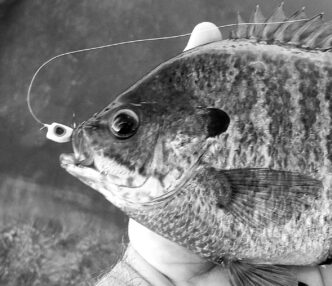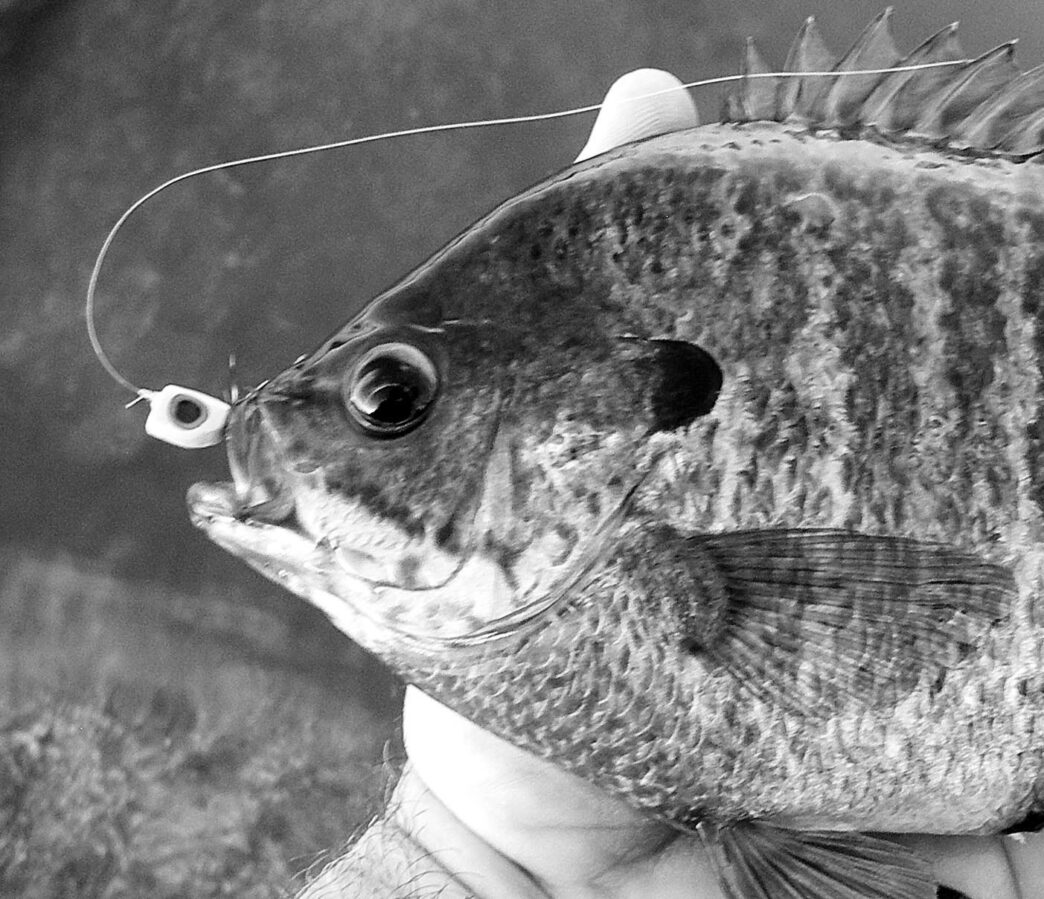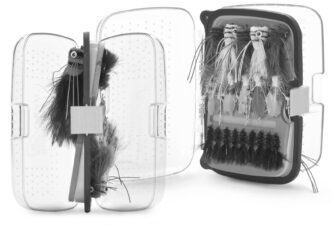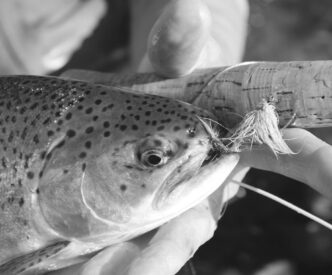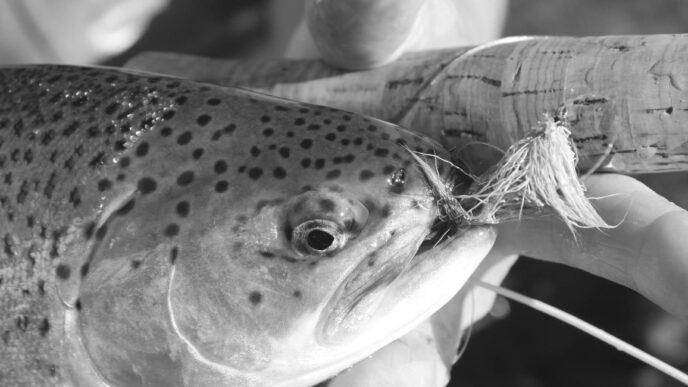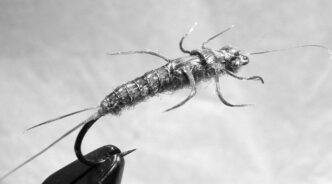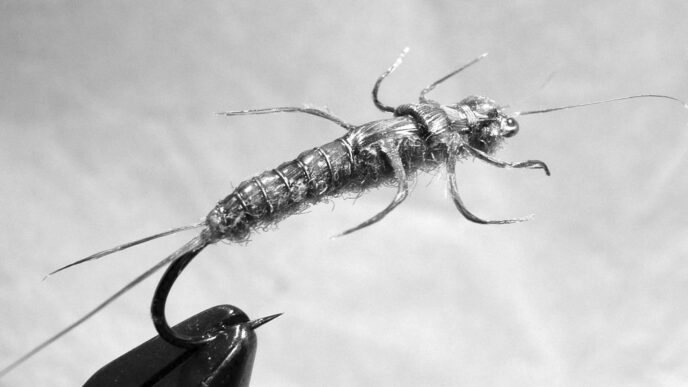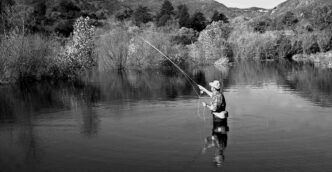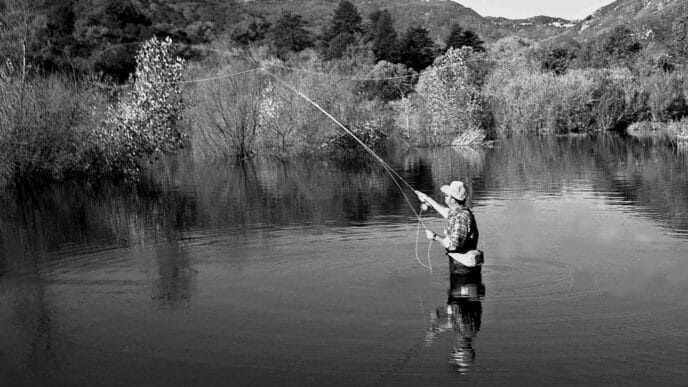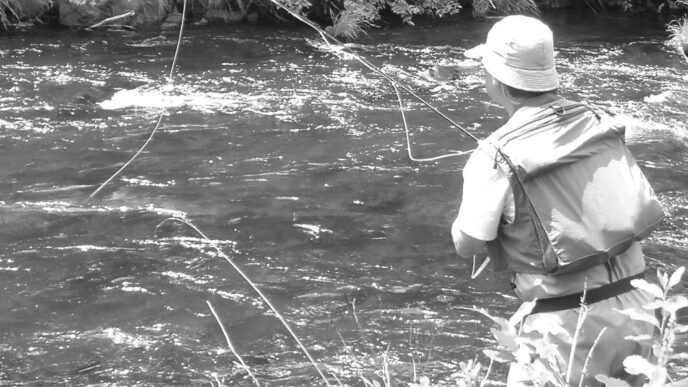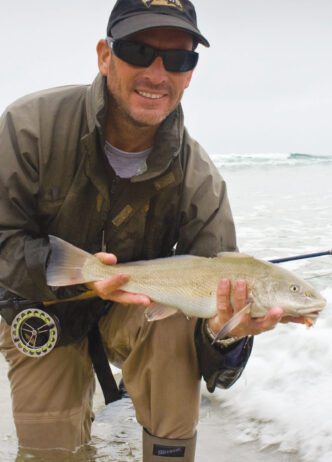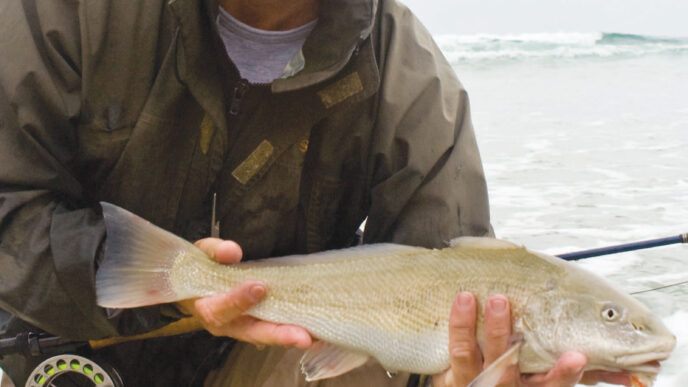Splitting some kindling for the fireplace in the cabin, I noticed one of the logs was light — both in color and in weight. Usually, we had oak in the woodpile, but this log revealed its pale color and a deep fiddleback in the grain when it was split. Taking out my pocketknife, I shaved off the rough side on one of the small pieces. It was a soft, yet dense-grained wood with beautiful color. I set the nice fiddleback log aside, remembering where I’d cut it just the day before while collecting firewood.
I wasn’t thinking about tying popping bugs at the time, but the wood had lovely color and grain. I had been making rubber-band quail calls for the last few years out of pretty chunks of wood that I had collected myself while hunting and fishing, usually from pieces of mesquite or burned manzanita. This soft, pale wood would be easy to work. (I’d tinkered with old oak logs by the hunting camp, and while they had a nice color and a grain like
I’d never seen in commercial oak, they also never seemed to be completely dry and stable. The small pieces I cut to make the calls continued to warp. In fact, some have continued to twist and curl for years with each change in the weather.)
The next day I chainsawed more slabs off the fallen, dead tree, and within a few days of questioning people and poking through tree guides, I had identified the wood as California buckeye. Back at home, I bandsawed some chunks and made my first of many buckeye quail calls. Harder woods make better quail calls, but there were many things to like about the buckeye, even if it wasn’t perfect for this task.
That’s actually Part Five of this story, but my discovery of California buckeye is perhaps the defining moment in the tale.
Part One: Like many older fly fishers, I’ve been tying my own flies and deer-hair popping bugs as long as I’ve been using a fly rod — actually, longer, in my case, because I bought a fly-tying kit before I could fly cast or even owned a fly rod. While many fly fishers tie, only a handful realize that tying once was an aspect of fly fishing that helped cement its inclusion into the family of “blood sports.” Since I also hunt, stop to look at rural roadkills, and know a number of taxidermists, a lot of my flies have been tied with fur and feathers from a dead animal with which I’ve had a visceral connection, often by eating it. Back before chicken farmers Metz and Hoffman learned how to breed birds with long, silky saddle hackles and stiff, properly colored, even-tine-length neck hackles, we had a heck of a time finding good capes. We were forced to use the necks from either fighting cocks or Indian gamecocks (wild chickens), although little bantam roosters sometimes had a few dozen or so good hackles and saddle feathers, and many old-timers raised chickens and plucked or trimmed the choice feathers each year, rather than lopping the bird’s head off and getting just one meal and one batch of feathers. You could skip one meal a year for good feathers. I still use the lightest-wire hooks I can find and oversized hackle on all of my dry flies today because of lessons learned from those early years, but they float high and dance over riffles, especially with today’s good capes.
I started bass fishing with a fly rod early on, and I’ve made poppers with hollow hair from pronghorn antelope, mule deer, elk, and caribou that I shot or with material pilfered from a taxidermy shop where I watched the head mounted. I’m not sure I’ve ever bought any deer hair for poppers, and the real advantage of skinning off your own pieces comes from the fact that you can cherry pick the stuff that is optimal for what you like to do. I still tie clipped deer-hair bodies on small dry flies from a piece of Wyoming pronghorn belly hide off the first pronghorn buck I ever shot, quite a few years back. The fibers are small in diameter and spin wonderfully with light thread, but they float the hook like cork.
Cork. There’s that word, that material.
Part Two: Poppers made of cork or balsa always intrigued me. Since I starting tying flies at eight or nine, I’ve wanted to make my own hard-body popping bugs. But it was a whole different process. It wasn’t tying so much as woodworking, gluing, and painting — a whole new set of tools and skills. It was always something I was going to do tomorrow.
Hank Neverka, the originator of Bass Poison Poppers and float-tube fly fishing on the backwaters of the lower Colorado River, used to visit all of the local fly-fishing clubs in Southern California, show slides of his adventures, and sell poppers. I’ve bought flies before, but it always seemed sort of sleazy to me: too quick, too easy, the patterns too neat and tidy, too commercial. But buying Hank’s poppers seemed more like supporting an artist. The paint jobs were bright and eye-catching. An Adams is elegant and delicate like an eyes-closed kiss; a fly-rod popper in bright yellow and with painted-on eyes and scales is just wild, smeared-lipstick sex. Ei-haaa.
I always picked up a few of Hank’s poppers each time I saw him, and we would talk about how he made them. He knew I really wanted to make my own, and one time he gave me half a dozen or so of his painted poppers, sans feathers. I finished them using four big neck hackles, paired and trimmed to shape, and another hackle wound right at the base of the cork head, just like he did. He even gave me a prototype popper, a long, skinny, minnowlike popper that sort of reminded me of a fly-rod Rapala and that would spit water. It was something he was tinkering with at the time, and he gave it me to try and to inspire me to start making my own hardbody bugs.
Hank is gone now, but I still have a few of his poppers, including that prototype, and fish them each year as a tribute to the man who was a mentor to a whole generation of Southern California fly-rod bass anglers. On a still morning, you can hear a Neverka Bass Poison Popper blurp for over 100 yards on a tule-lined backwater near Martinez Lake on the Colorado River. “This chug’s for you, Hank,” I think when I pop one on that first cast.
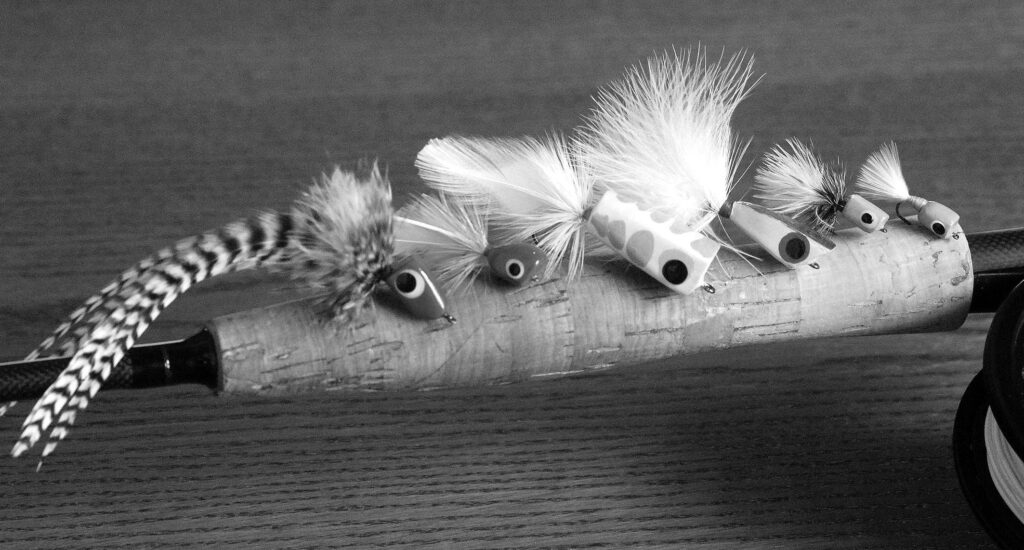
Part Three: As a newspaper outdoor writer, you get to meet and write about some really cool people. I met Allan Cole over 30 years ago, when I wrote a story about his loose-knit organization called the Brownbaggers. To quality for membership, you had to have caught two brown trout weighing more than 10 pounds — two to prove that the first one wasn’t just a lucky fluke. The “president” is the guy who’s caught the biggest one. Cole caught his thirty-first brown over that benchmark just this summer, fishing with his son Eric in Oregon, and — of course — he caught it with a lure he made.
Allan is a natural-born PR man who understands the whole concept of sound bites and what makes news. When he started marketing his home-made, monstrous A.C. Plugs, he got tons of press because he was colorful and said controversial things. What sometimes got lost in the translation was Allan’s sense of humor. He’s never taken himself as seriously as the quotes in some stories made it seem, because all of his lines were delivered with laughter, actual or implied. He is a kid who has never grown up, and when you see him hook a fish, it is still with the glee of a kid catching his first bluegill. He gets that excited every time.
As with fly tying, making your own oversized plugs to catch trophy trout and bass is a way to immerse yourself deeper into the game and to extend your time on the water, even if it is just mental time. When Allan is cutting, sanding, putting on the hardware, and then painting his 8-to-12-inch plugs, he’s imagining them in the water. Isn’t that what you do when tying flies? After Allan and I became friends, I would spend time with him in his garage, looking at his work in different stages and talking with him about wood and how different types work and swim in the water, how they float, and how they hold paint. We discussed the design of his plugs and how the A.C. Plug was the closest replica to a hatchery rainbow trout ever made when it first came out — both in paint job and in action. The big, hidden-joint plug with a rubber tail swam like a dazed, freshly planted hatchery fish, and the big brown trout, striped bass, and monster largemouths were pretty easy to dupe with the imitation. To my mind, it was one of the first imitative lures ever made for bass anglers. When Allan made an 18-inch version out of one of his son’s broken baseball bats (Eric played as high as AAA baseball, but never quite made it to the bigs) to imitate a holdover rainbow, I laughed. When he actually fished it and caught a striped bass on the lure, I started thinking again about the wooden popper thing for my fly fishing. To get what I really wanted in a surface popper, I was going to have to make it out of the right wood.
Part Four: It took me 30 years to balloon up from a skinny 170 pounds to 235 pounds at my peak fat-boy weight early last year. Most of the weight was gained during the last years after I’d turned 50, quit coaching Little League, mostly had my two boys move out of the house, and when my brother-in-law’s first marriage was slowly beating apart on the rocks. There was a lot of wine being consumed, with overly extravagant fish-and-game dinners served with too much good bread and potatoes cooked all ways they can add inches to a girth.
R. G. Fann, my wife’s brother, has been my longtime fly-fishing compadre and best friend for nearly 30 years. (I forgave him a long time ago for introducing me to his sister.) He and I cook, often for hours, drinking and talking about our fishing all over the West together and planning future trips. I slice, dice, and chop, and he marinates, flambés, sautés, stews, and barbecues. We take time to listen to music, maybe do a few solo dance moves, and gaze up at the stars. My wife, his sister, Becky, suggests we may drink too much while all this is happening. It seems like we always end up cooking after our spring-summer trips to Lake Perris to fish for bass with popping bugs. I think it was one of those times when R. G. picked up a wine cork, held it overhead, twirling it, and proclaimed, “Vintage poppers.”
It never takes long for an idea to turn into a full-blown project, complete with marketing scheme, during our lubricated cooking adventures. The Vintage Popper project consisted of making popping bugs from wine corks and applying a clear finish so you could see the cork’s wine vintage information — thus the name. But they would be tied in vintage popper style, like Neverka’s, with big, natural neck hackles trimmed into a pair of splayed legs and natural-colored hackles wrapped at the base. By necessity, they would be big, perhaps not too big for bass, but maybe too big for many fly rods to handle. That was not going to be a problem, because we figured that most would be sold as novelty items at slightly gouging prices to our flyfishing counterparts. We would even have a custom department so an angler could send us a cork from an important occasion or expensive vintage, and we would create his own personal Vintage Popper — for more money, of course. We knew some woodworkers about to retire who would need something to do and figured we could outsource the actual tying to fishing guides in their off-season. We could provide the corks. We were going to make a couple of prototypes the next day.
As time went by, it still seemed like a really good idea to us after a bottle or two of red wine, but we’d never actually got around to making one.
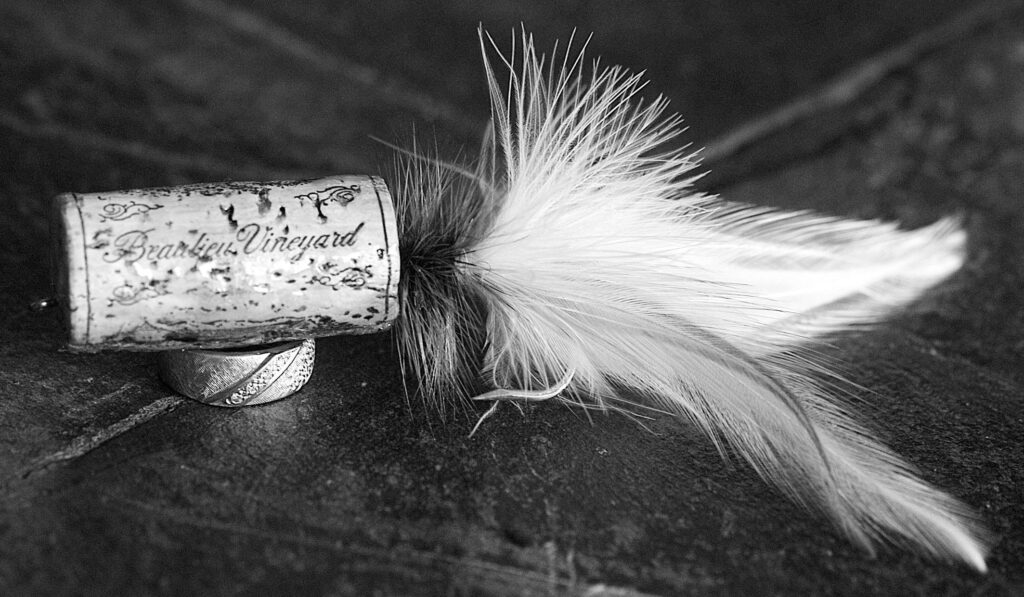
Part Six: Making the small quail calls out of lovely pieces of wood warped me into looking at shrubs and trees differently. I would wonder what kind of grain would be hidden in a twisted fork in a tree branch, and I would marvel at the colors in the heart of a bulldozed rootstalk of creosote at the edge of a new desert housing development. There is now always a good handsaw in my pickup truck for cutting samples, later to slice into little rectangular blocks to see if they would make an attractive call.
I’m not sure if it was a coincidence that most of the chunks of wood I make into calls are about the same size as a typical bass plug. Daydreaming, I was idly belt sanding a piece of California buckeye that was a little too small for a call when I realized that the shape would make a passable fishing plug. I worked on it another five minutes and then hand-sanded it into final form. It looked about right for a shad imitation, but it was light, and wouldn’t cast worth a hoot on a bait-casting rod. Weighing it in my hand, I realized that casting it would be tough even on spinning tackle. It ended up in my fly-tying desk drawer. Over the next six months, I made a couple of more plug bodies out of the buckeye. They were all in the drawer, waiting.
When the trout opener was coming up in the eastern Sierra this past year, I started going into the garage to tie egg patterns and beef up the dry-fly portions of the trout boxes for the summer. I had to move the plug bodies to get to things each time I went out. Looking for hooks in another drawer, I came across eight or nine boxes of kink-shanked popping-bug hooks in all sizes.
Something finally clicked. The California buckeye bodies were in my hands, and I was lifting them up and down. They were really light — heavier than balsa, but closer to cork. They would be perfect for fly-rod popping bugs.
That was it. I had been planning on doing this for decades now, and all the pieces suddenly fell into place. I took the popper hooks and grabbed some epoxy. With the plug bodies, I went over to the band saw and cut them into pieces so they were perfect sizes for fly-rod poppers and then did some more shaping on the belt sander. The band saw blade turned out to be the perfect thickness to cut a groove for the hooks, and I sliced halfway through the popper bodies and then proceeded to epoxy hooks into them.
An hour later, I had over two dozen popper bodies on hooks, ready to shape into final form. Emery boards were perfect for this, because the buckeye is soft and sands easily, but I also made a few of my own sanding boards with ice cream sticks, fine-grit sandpaper, and spray glue. I used a Dremel tool to cut mouths on the face of the bugs to make them blurp. Others I shaped like bullets to slip through the water like a minnow, some were like grasshoppers, and some like frogs.
I dipped several of the bugs in white primer paint to seal them and give me a painting base, sprayed some, and brushed others. I decided that I’d just use a brush for everything in the future, because it seems so old school. I put on two coats of primer over a couple of days. Then I added the body color of choice another day and then started adding eyes and spots and flash the next. I learned that from watching Allan. While the paint was drying, I cut some more buckeye and glued the pieces to more hooks. No, this wasn’t fly tying — it was a bug-making production line. It was a step process that can take days from start to finish, but there were always bugs in different stages to inspire the imagination.
Suddenly there were two dozen bugs of all sizes and colors on my tying bench, ready for the final tying step. When the first buckeye popper came out of the vise, I was giddy. I ran into the house to show it to Becky. She said it was “nice.” Nice my ass — this was the culmination of a project that had been coming together for 45 years. It was unfreakingbelievably cool.
One of the things that I had always wanted was a set of really small popping bugs for bluegills, size 12s and 14s. There they were on the bench. I wanted bass bugs that would float deeper in the water, like a real frog, but that didn’t get waterlogged like a hair bug or skip off the water like so many other balsa or Styrofoam poppers. There they were. I wanted bugs that shoot little spurts of water forward when you pop them, bugs that could make a string of bubbles as they twitch across the surface, and bugs with a cavernous mouth that would really glug. There they all were. None of them were exactly the same, and even the ones that were a little lopsided looked good in the water. One would roll, dive, and pull to one side, kind of like a real injured minnow. I looked carefully at that one to see why it did that so I could try to duplicate it.
When I came across a couple of wine corks in the flurry of activity, I went over to the band saw and carefully cut slices through to the middle. R. G. called that very evening to say he had a date with a new woman.
Finale: I went up to Lake Silverwood on a Friday evening after a long week with too many deadline stories. I wanted make a bunch of double-haul casts with the long 6-weight rod off a point and watch it get dark. I threw a streamer for a while, working out the muscles, but never had a bump. I’d almost forgotten that one of the fly boxes had a bunch of my freshly tied buckeye poppers. The trip hadn’t been about fishing until then.
Just as the sun winked behind the hill, I tied on a small, bright-yellow bug finished with snipe and quail feathers from birds I’d shot and eaten last fall. Looking at it, I realized this was about as old school as you could get. Other than the hook and thread, I had a connection to each material used in every step of the process. Was this the ultimate in fly fishing? I worked the little popper around the big, submerged boulders in the water off the point, thinking it might bring up a bluegill or small bass. After 10 minutes, I realized I needed to take off my sunglasses, and I tucked the rod under my arm and pulled out my regular glasses’ case to make the swap. The bug was sitting 30 feet offshore above a pair of granite slabs. I switched back and forth a couple of times to make sure I wanted to go back to my regular, nonpolarized glasses and was just putting the sunglasses in the case when the bug disappeared in a big swirl.
The hook set was inelegant, at best, because I lifted the rod with my forearm, about dropped the cased glasses, and slipped on the rock where I was perched, but the fish was on tight. It pulled surprisingly hard, boring back toward the rocks twice before I had a glimpse of it. It was perhaps the biggest bluegill I’d ever caught on a fly rod, a thick-bodied, 10-inch fish that probably weighed over a pound.
A week or so later, at Vail Lake with fellow fly-fishing writers Rick Bean and Jeff Walters, I caught the biggest largemouth bass I’ve ever landed on a fly-rod surface bug — on one of my buckeye poppers. It was maybe five pounds.
R. G., after saying he was swearing off women, has fallen in love again. The Vintage Poppers came out really nice, and they are going to be a wedding present, if and when it gets that far. I made a his-and-hers set with corks from her favorite white wine and his favorite red wine.
Long journeys to an uncertain destination can be filled with enjoyable waypoints, and sometimes you find exactly what you were seeking when you realize you’ve arrived. Now I’m not going to say you are going to catch the biggest fish of your flyfishing career if you make your own buckeye surface bugs or that your dearest friends and family will find love and happiness if you start creating Vintage Poppers. But what do you have to lose?



